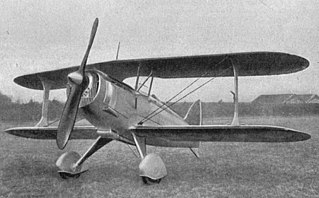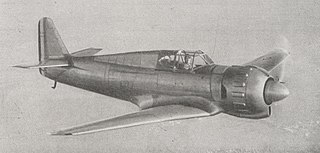| Dewoitine 371 | |
|---|---|
 | |
| A Dewoitine D.371 | |
| Role | Fighter |
| Manufacturer | Dewoitine / SNCAM / SNCASE |
| Designer | Emile Dewoitine |
| First flight | August 1932 |
The Dewoitine 37 was the first of a family of 1930s French-built monoplane fighter aircraft.
| Dewoitine 371 | |
|---|---|
 | |
| A Dewoitine D.371 | |
| Role | Fighter |
| Manufacturer | Dewoitine / SNCAM / SNCASE |
| Designer | Emile Dewoitine |
| First flight | August 1932 |
The Dewoitine 37 was the first of a family of 1930s French-built monoplane fighter aircraft.
The D.37 was a single-seat aircraft of conventional configuration. Its fixed landing gear used a tailskid. The open cockpit was located slightly aft of the parasol wing. The radial engine allowed for a comparatively wide fuselage and cockpit.
Design of this machine was by SAF-Avions Dewoitine but owing to over work at that companies plant at the time, manufacture of the D.37/01 was transferred to Lioré et Olivier. They were high-wing monoplanes of all-metal construction with valve head blisters on their engine cowlings. The first prototype flew in October 1931. Flight testing resulted in the need for multiple revisions in both engine and airframe, so it was February 1934 before the second prototype flew. Its performance prompted the French government to order for 28 for the Armée de l'Air and Aéronavale . The Lithuanian government ordered 14 that remained in service with their Air Force until 1936, when they were sold to the Spanish Republican government.

In spite of its superior speed, this design failed to impress and was even refused when exported to Lithuania in 1935. An important competitor of the Dewoitine D.37 family was the Polish PZL P.24, a similar type but with better speed and armament.
In 1936, at the beginning of the Spanish Civil War, 12 or 14 D.371s were sold, unofficially, to the Spanish Republic as part of a squadron of volunteers organized secretly by André Malraux, named España. They were, however, unarmed due to the political stance of the French government that declared its neutrality very early.
In August of the same year, after some negotiations with the French government, three fully armed D.371s arrived in Barcelona, piloted by the mercenary pilots M. Poulain, René Halotier and Henri Rozés. They saw action as escorts of a bombing raid against Talavera de la Reina, Toledo that destroyed the headquarters of General Juan Yagüé. These three D.371s had successfully defended their bombers against the attacks of six German Heinkel He 51 biplane fighters - an older-design aircraft with inferior performance.
The Squadron España operated with these aircraft until the arrival of the modern Polikarpov I-15 and I-16, at which time the three Dewoitine 371s were withdrawn from the front and continued as training aircraft. However, they reappeared later in some squadrons and one is known to have flown with the 71 Fighter Group by the Yugoslav (Slovenian) volunteer pilot Josip Križaj. All Dewoitines left were practically destroyed after having been bombed by the Legion Condor aircraft in the airfield of Bañolas.

General characteristics
Performance
Armament
Aircraft of comparable role, configuration, and era
Related lists

The Dewoitine D.500 was an all-metal, open-cockpit, fixed-undercarriage monoplane fighter aircraft designed and produced by French aircraft manufacturer Dewoitine.

The Amiot 354 was the last in a series of fast, twin-engine bombers which fought with the French Air Force in limited numbers during the Battle of France.

The Blériot SPAD S.510 was a French single-seat, single-engined biplane fighter aircraft. First flying in 1933, 60 were built for the Armée de l'Air, entering service in 1936. The type remained in service as a fighter-trainer at the start of the Second World War. It was the last French biplane fighter to enter production.

The Bloch MB.150 was a French fighter aircraft developed and produced by Société des Avions Marcel Bloch. It featured an all-metal construction, complete with a retractable undercarriage, low cantilever wing and a fully enclosed cockpit.

The Bloch MB.210 and MB.211 were the successors of the French Bloch MB.200 bomber developed by Société des Avions Marcel Bloch in the 1930s and differed primarily in being low wing monoplanes rather than high wing monoplanes.

The Bloch MB.170 and its derivatives were French reconnaissance bombers designed and built shortly before the Second World War. They were the best aircraft of this type available to the Armée de l'Air at the outbreak of the war, with speed, altitude and manoeuvrability that allowed them to evade interception by the German fighters. Although the aircraft could have been in service by 1937, debate over what role to give the aircraft delayed deliveries until 1940.

The PZL P.24 was a Polish fighter aircraft, designed during the mid-1930s in the PZL factory in Warsaw. It was developed as a dedicated export version of the PZL P.11, a gull wing all-metal fighter designed by Polish aeronautical engineer Zygmunt Puławski.

The Koolhoven F.K.58 was a single engine, interceptor-fighter aircraft designed and mainly manufactured by N V Koolhoven in the Netherlands under contract by France. Intended for Armée de l'Air use, the F.K.58 saw limited service in the Battle of France.

The Farman F.220 and its derivatives were thick-sectioned, high-winged, four engined monoplanes from Farman Aviation Works. Based on the push-pull configuration proven by the F.211, design started in August 1925 and the first flight of the prototype was on 26 May 1932. The largest bomber to serve in France between the two world wars was the final F.222 variant. One variation was intended to be an airliner.

The Dewoitine D.27 was a parasol monoplane fighter aircraft designed by Émile Dewoitine in 1928.

The Morane-Saulnier M.S.225 was a French fighter aircraft of the 1930s. It was produced in limited quantities to be used as a transitional aircraft between the last of the biplanes and the first monoplane fighters.

The Bleriot-SPAD S.51 was a French fighter aircraft developed in 1924 in response to a French Air Force requirement for an aircraft to replace their obsolete Nieuport-Delage NiD.29s.

The Loire 46 was a French single-seater fighter aircraft of the 1930s. A high-winged monoplane designed and built by Loire Aviation, it was purchased by the French Air Force. It was also supplied to the Spanish Republican forces during the Spanish Civil War, but was almost out of service by the outbreak of World War II.

The Dewoitine D.1 was a French single-seat fighter aircraft of the 1920s, built by the French industrial company Dewoitine.

The Dewoitine D.21 was 1920s French open-cockpit, fixed-undercarriage, parasol winged monoplane fighter aircraft.

The SNCAO CAO.600 was a French prototype twin-engined torpedo-bomber of the Second World War. It was intended to operate from two new aircraft carriers of the French Navy, but only a single example had been completed and flown when the surrender of France in June 1940 ended development of the aircraft.

The Nieuport-Delage NiD 120 series was a series of French single-seat parasol monoplane fighter aircraft of the 1930s. It was built in a number of versions, fitted with various types of engines, with six aircraft designated NiD 123 being sold to Peru.

The Dewoitine D.9 was a French monoplane fighter built by Dewoitine and built under licence in Italy as the Ansaldo AC.3.
The Wibault 313, Wibault Wib 313 or Penhoët Wibault Wib 313 was a single engine, single seat low wing monoplane fighter aircraft, designed and built in France in the early 1930s. It was entered into a government competitive tender programme but was not ordered.
The Dewoitine D.15 was a single-engine, single-seat biplane fighter aircraft built in France in the 1920s. Intended to offer structural simplifications when compared with monoplanes, it had a disappointing performance and was soon abandoned.